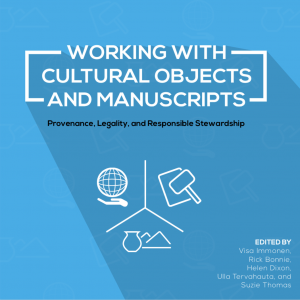Nothing to do with us? New book sheds light on illicit trade of cultural objects

A new edited volume in the publication series of the Finnish Museums Association shows that the illicit trade in cultural objects is a topical issue also in Finland. It requires the attention of decision-makers, antique dealers, cultural heritage professionals and scholars alike. The civil war in Syria and the rise of terrorist organizations such as ISIS across the Middle East and North Africa have produced an ongoing humanitarian disaster. They have also created a wave of crimes involving ancient objects and significant cultural and historical sites. Media reporting has revealed this destruction of cultural heritage, as well as the looting and trafficking of antiquities. It is often assumed that these violations are confined to the countries of origin of cultural objects or to international centres of trade like Brussels, London and New York. However, illicit trafficking of antiquities and related distribution networks are a grave concern in the Nordic countries as well.
The collection Working with Cultural Objects: Provenance, Legality, and Responsible Stewardship consists of ten contributions. Articles by the renowned international experts Patty Gerstenblith, Neil Brodie and Christopher A. Rollston are translated into Finnish, and they provide an up-to-date understanding of the ongoing international debate. Rollston focuses on the history of counterfeiting, which is closely related to the illicit trade in antiquities, while Brodie evaluates the responsibility of scholars in working with cultural objects of uncertain provenance, and Gerstenblith examines the 1970 UNESCO Convention and its implementation in different market countries.
Other articles in the collection are in English and written exclusively for this volume. Raila Kataja, Magnus Olsson and Josephine Munch Rasmussen describe efforts to prevent illicit trade of cultural goods in Finland, Sweden and Norway. Anni Guttorm discusses the repatriation of Sámi artefacts, Eero Ehanti presents ICOM’s measures to prevent illegal trade, and Nidaa Dandachi summarises how Arabic-language news reporting has reported on the plundering and trafficking of Syrian cultural heritage.
The publication is an outcome of the University of Helsinki research project Working with Cultural Objects and Manuscripts (WCOM), and the articles are based on presentations given at an international symposium organized at the National Museum of Finland in 2017 (https://blogs.helsinki.fi/culturalobjects/). That event brought together scholars across various academic disciplines and representatives from several Finnish and international cultural heritage institutions. The aim was to raise awareness on illicit trade of cultural objects in the Nordic countries and Finland in particular. It is also vital to acknowledge that the international community of scholars and heritage experts are increasingly emphasising the responsibility universities and museums have towards cultural objects of questionable provenance.
The project and the international symposium were funded by the Future Fund of the University of Helsinki and the publication also by the Department of Archaeology at the University of Turku, the Centre of Excellence in Ancient Near Eastern Empires, and the Centre of Excellence in Changes in Sacred Texts and Traditions. In addition, the project was supported by the National Museum of Finland and ICOM Finland.
Link to the publication: https://museoliitto.fi/index.php?k=13167










 Stumble It!
Stumble It!

No comments:
Post a Comment